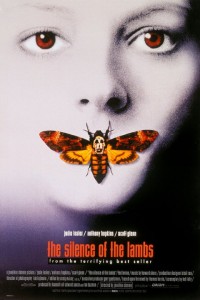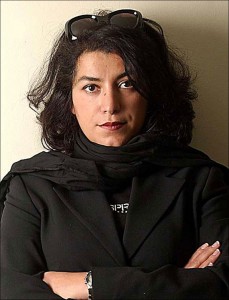An example of a hybrid documentary is The Cove. The documentary is expository when it addresses the issue of Japanese dolphin slaughter. However, it is also a participatory documentary when the filmmaker engages with subjects in Japan to provide their own opinions about the issue.
Monthly Archives: March 2015
Ending of Persepolis
I feel like the entire point of Marjane telling the audience her story, was just to lead up to the ending. There really was no context of why she started the story besides letting us know how she got to America and all the events leading up to it. I felt like that very last scene in which the taxi driver asks her where she is from and she just responds “Iran” that even though she will try to explain where she is from with all her chaotic background, people will just here Iran and feel like that’s something interesting. No one will ever no all the wars and heart breaking trouble that she had to go through just to stay alive and make it to America. The only thing that they will hear is “Iran” and perhaps think about some recent events but would never actually link it to the person that you were talking to. Many people would think how could this person possibly have any involvement with what actually happened in Iran, she was probably away from all the mess. This could prove to be true in some circumstances, but not this one, and a person like Marjane would just be too exhausted to even explain her story. After all, it did take a total of two hours.
Persepolis: A Different Type of Animation
I have never seen any type of animated film like Satrapi and Paronnaud’s 2007 film Persepolis. In general, most animated films are created for children, such as many of the Disney classics. Meanwhile, Persepolis is animated film more geared to adults. In a traditional animated film there is always a happy ending that deals with being true to yourself and finding your true love. Usually, these films involve prince and princesses, magic, evil witches, and so on. In contrast, Persepolis deals with a personal story blended with historical events. Although it wasn’t exactly based on a specific person’s true story it could very might have happened to someone. Thus, due to the realism of the plot, viewers can develop a personal connection to the story. With such a complex story being told in animation, I found it very interesting how the animation was created with simple shapes and basic colors. This helped to focus more on the importance of the story at hand instead of being distracted by textures and colors.
Chinatown Symbol
In Polanski’s 1974 film Chinatown, there were many interesting symbols to be identified.One example is the title name, Chinatown. Chinatown is not just a place that Jack Nicholson’s character fears. It is a place that stands for corruption where authority means nothing and there is no room for good intentions. This can be seen from both Nicholson and Faye Dunaway’s characters. J.J. Gittes has the good intentions of solving the crime about the death of Evelyn Mulwray’s husband and the corruption going on in the authority of the city and how Mulwray wants to keep her daughter safe and attempts to leave but is killed. The conclusion is that nothing good can come from Chinatown.
The Graduate
The sound and camera angles in Mike Nichols’s 1968 film The Graduate gave a greater insight to the life of the main character Ben. From what the audience can see, Ben has just graduated from college and does not know what he is going to do now that he has just finished. Specific scenes in this movie show how pressured Ben really feels.
Examples include how in the opening scene there is a party in Ben’s honor taking place at his home and there are many people. The camera is very close up and gives the audience a sense of a claustrophobic feel. At this time everyone is greeting Ben, shaking his hand, kissing him, and asking many questions. With the camera so close, you feel as though Ben is feeling very pressured by all that is happening and is just being pushed through. Two other examples include water scenes. In Ben’s room he has a tank and is constantly seen looking through the tank at his fish and nothing but the sound of bubbles can be heard. Also, Ben is given a scuba suit and is forced to go in the pool with it. All that can be heard is Ben’s heavy breathing and all the people crowding around him. Being under water for so long gives a feeling of suffocation and once again, a pressurized environment is being displayed.
The Title “Persepolis”
It has been a couple years since I’ve read the graphic novel Persepolis, and I am not sure whether or not they explain the title in the novel, but I realized that “Persepolis” isn’t actually said or directly referenced in the film, so some people walk away confused as to why the novel/film is titled that.
Persepolis (translated to “city of Persians”) was the ceremonial capital of the ancient Achaemenid Empire (an empire centered around Iran between 550-330 BC) and now a famous area of ruins in Fars Province, Iran. It was once a spiritual and social center, where a variety of religious ceremonies took place, and its close proximity to a river also allowed it to be an economic hub as well. Since the fall of the Empire, the city slowly decayed over time, but is now considered an area of architectural masterpieces, with my archeologists praising its statues and depictions of religious figures.
By titling her novel/film Persepolis, Marjane makes a reference to the old days of her country, drawing parallels between the life she lived with the society that existed in the same place millenniums before. When Marji is young, she expresses a strong desire to become a prophet, and even though she enjoys many modern fads, she seems to have a deep respect for the past. The title indirectly reflects this, and almost expresses Marji’s sadness and regret over the turmoil that her nation has suffered, even after it was established, more or less, so long before she was born.
Feminist Film Theory
 I’m not sure how many of you guys have seen Jonathan Demme’s magnificent film Silence of the Lambs (1991), but I was wondering if this film could be a good example for the Feminists Film Theory. What do you guys think of this based on the idea of the male protagonists, who is a cannibal, through the gaze of the spectator, and following her body?
I’m not sure how many of you guys have seen Jonathan Demme’s magnificent film Silence of the Lambs (1991), but I was wondering if this film could be a good example for the Feminists Film Theory. What do you guys think of this based on the idea of the male protagonists, who is a cannibal, through the gaze of the spectator, and following her body?
Marji Unanimated: The Author Since Persepolis
While watching Persepolis, it is very easy to get lost in the plot and the beautiful animation style, sometimes to the point where we forget that it is a true story and that the character Marji not only existed, but is still alive. Her story didn’t end with the taxi drive from the airport, or with her grandmother dying, but continued long after that.
Since Persepolis ended, Marjane Satrapi has obviously become a famous graphic novelist, having published Persepolis Parts I and II in 2000, four-five years after the story of Persepolis ends (when Marji leaves Iran for good). After moving to Strasbourg, France, and following the immense international success of her debut work, Marjane continued to write graphic novels, including Embroideries and Chicken with Plums, which have won multiple awards and many of which also address the civil tensions in Iran.
Since the success of the Persepolis film in 2007, Marjane has also continued her career in the film industry, continuing to work with Vincent Paronnaud (the co-director of Persepolis) to create other films such as a live-action adaptation of Chicken with Plums and a comedy-horror film The Voices (a film starring Ryan Reynolds and Anna Kendrick). She has also made multiple public appearances (including some at Parliament) to advocate for the rights of women in Iran and internationally, continuing her messages and beliefs in Persepolis.
Also, in case any of you were worried about her love life (because, let’s face it, from what we saw, Marji kind of got the short end of the stick with that one in the film), since Persepolis she married Mattias Ripa, a Swedish national, and the two have lived in Paris since then. And another interesting thing to note is that Marji speaks six languages (Persian, French, German, Swedish, German, and Italian)!
Prejudices in Looney Tunes
I brought this up in class briefly the other day, but I was curious to find more information about it so I did a bit of research. Many old Looney Tunes cartoons featured very racist depictions of various stereotypes and, as a result, many of these cartoons are very off-putting and quite offensive, while still being very interesting pieces of film history. When released on DVD, these cartoons were preceded by the following quote.
The cartoons you are about to see are products of their time. They may depict some of the ethnic and racial prejudices that were commonplace in the U.S. society. These depictions were wrong then and they are wrong today. While the following does not represent the Warner Bros. view of today’s society, these cartoons are being presented as they were originally created, because to do otherwise would be the same as claiming that these prejudices never existed.
I also found this other disclaimer, presented by Whoopi Goldberg, which is in the same vein as the previous disclaimer.
I find this fascinating, as the cartoons themselves are incredibly well made, despite containing very offensive material. I think it’s admirable of Warner Brothers to admit their past faults, while still preserving the artistic side of these creations.
Persepolis: Character Progression
After watching this film, I managed to grasp onto the simplest form of character progression in a movie. Although the movie was animated, I felt that after watching the simplest of parts, character progression is hard yet easy to notice at the same time. When you can visibly see a difference in the character’s appearance or tone of voice, it is evident that they have aged. When you hear character’s change of opinion due to maturity, it’s easy to notice how they’ve grown through experience and learning. If you take those two elements out of the equation, it is harder to notice. I think it is important to look for ways the character has changed (not physically or through narration) but through dialogue and interactions with other characters. It isn’t direct but it could be important to look for. Who knows, maybe you’ll find something else in your search.


